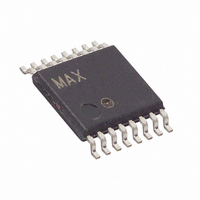DS1859E-020+T&R Maxim Integrated Products, DS1859E-020+T&R Datasheet - Page 25

DS1859E-020+T&R
Manufacturer Part Number
DS1859E-020+T&R
Description
IC RES TEMP 20/20K 3MON 16-TSSOP
Manufacturer
Maxim Integrated Products
Datasheet
1.DS1859E-050.pdf
(28 pages)
Specifications of DS1859E-020+T&R
Taps
256
Resistance (ohms)
20K
Number Of Circuits
2
Temperature Coefficient
50 ppm/°C Typical
Memory Type
Non-Volatile
Interface
I²C, 2-Wire Serial
Voltage - Supply
2.85 V ~ 5.5 V
Operating Temperature
-40°C ~ 95°C
Mounting Type
Surface Mount
Package / Case
16-TSSOP
Resistance In Ohms
20K
Lead Free Status / RoHS Status
Lead free / RoHS Compliant
After receiving a matching address byte with the R/W
bit set low, if there is no write protect, the device goes
into the write mode of operation (see the Memory
Organization section). The master must transmit an 8-
bit EEPROM memory address to the device to define
the address where the data is to be written. After the
byte has been received, the DS1859 transmits a zero
for one clock cycle to acknowledge the address has
been received. The master must then transmit an 8-bit
data word to be written into this address. The DS1859
again transmits a zero for one clock cycle to acknowl-
edge the receipt of the data. At this point, the master
must terminate the write operation with a STOP condi-
tion. The DS1859 then enters an internally timed write
process t
abled during this byte write cycle.
The DS1859 is capable of an 8-byte page write. A page
is any 8-byte block of memory starting with an address
evenly divisible by eight and ending with the starting
address plus seven. For example, addresses 00h
through 07h constitute one page. Other pages would
be addresses 08h through 0Fh, 10h through 17h, 18h
through 1Fh, etc.
A page write is initiated the same way as a byte write,
but the master does not send a STOP condition after
the first byte. Instead, after the slave acknowledges the
data byte has been received, the master can send up
to seven more bytes using the same nine-clock
Figure 5. 2-Wire Data Transfer Protocol
SDA
SCL
CONDITION
START
Dual, Temperature-Controlled Resistors with
w
to the EEPROM memory. All inputs are dis-
MSB
1
2
SLAVE ADDRESS
Write Operations
6
____________________________________________________________________
7
Internally Calibrated Monitors
Page Write
DIRECTION
R/W
BIT
8
SIGNAL FROM RECEIVER
ACKNOWLEDGEMENT
ACK
9
sequence. The master must terminate the write cycle
with a STOP condition or the data clocked into the
DS1859 will not be latched into permanent memory.
The address counter rolls on a page during a write. The
counter does not count through the entire address
space as during a read. For example, if the starting
address is 06h and 4 bytes are written, the first byte
goes into address 06h. The second goes into address
07h. The third goes into address 00h (not 08h). The
fourth goes into address 01h. If more than 9 bytes or
more are written before a STOP condition is sent, the
first bytes sent are overwritten. Only the last 8 bytes of
data are written to the page.
Acknowledge Polling: Once the internally timed write
has started and the DS1859 inputs are disabled,
acknowledge polling can be initiated. The process
involves transmitting a START condition followed by the
device address. The R/W bit signifies the type of opera-
tion that is desired. The read or write sequence will only
be allowed to proceed if the internal write cycle has
completed and the DS1859 responds with a zero.
After receiving a matching address byte with the R/W bit
set high, the device goes into the read mode of opera-
tion. There are three read operations: current address
read, random read, and sequential address read.
The DS1859 has an internal address register that main-
tains the address used during the last read or write
1
2
REPEATED IF MORE BYTES
ARE TRANSFERRED
3–7
SIGNAL FROM RECEIVER
ACKNOWLEDGEMENT
8
Current Address Read
ACK
9
Read Operations
OR REPEATED
CONDITION
CONDITION
START
STOP
25











